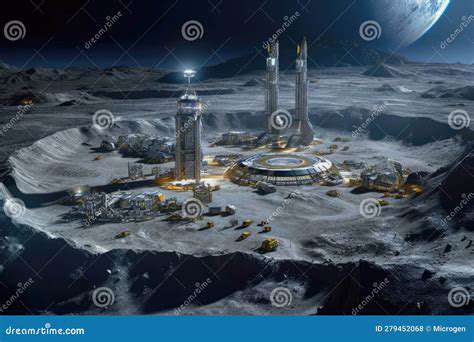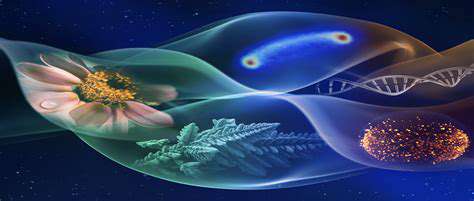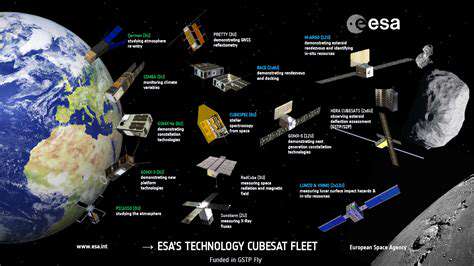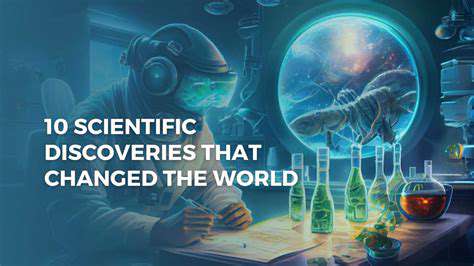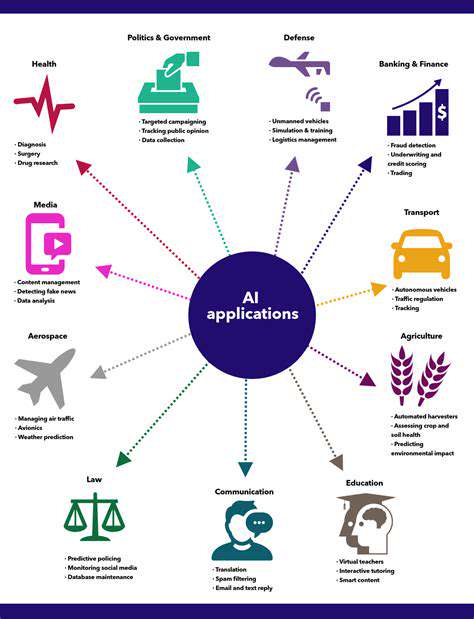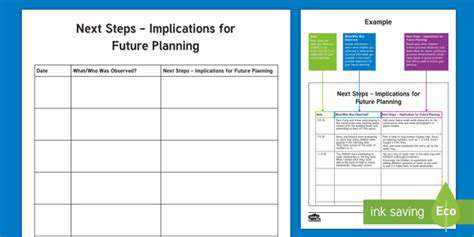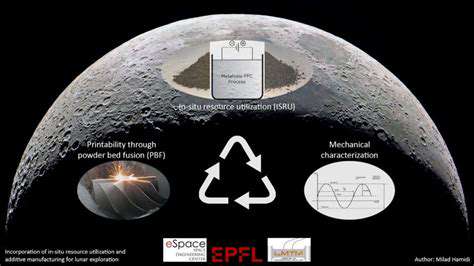
In-Situ Resource Utilization (ISRU) Fundamentals
Humanity's expansion into space demands innovative solutions for resource management. In-Situ Resource Utilization (ISRU) represents a paradigm shift in how we approach extraterrestrial exploration. This groundbreaking concept focuses on harnessing materials directly from celestial bodies, fundamentally altering our dependence on Earth-based supplies.
The economic implications of ISRU cannot be overstated—by leveraging local resources, we can slash mission costs by up to 60% while enabling more ambitious exploration programs. Lunar regolith contains surprising amounts of usable materials, including oxygen trapped in minerals and water ice hidden in permanently shadowed craters. NASA's Artemis program currently prioritizes ISRU development as a cornerstone for establishing sustainable lunar operations.
Resource Acquisition Techniques
Modern extraction methods combine robotic precision with advanced geological surveying. Engineers have developed specialized regolith excavators that can operate in the Moon's low-gravity environment, while spectroscopic analysis helps identify resource-rich areas. Recent breakthroughs in AI-assisted prospecting allow autonomous rovers to make real-time decisions about optimal extraction sites.
The European Space Agency's PROSPECT mission demonstrated how miniature drills can obtain subsurface samples with minimal energy expenditure. Meanwhile, microwave-assisted excavation shows promise for large-scale operations, potentially reducing mechanical wear and power consumption compared to conventional digging methods.
Material Processing and Conversion
Transforming raw lunar materials requires multi-stage refinement processes. The most promising technique involves molten salt electrolysis to extract oxygen from ilmenite (FeTiO₃), a common lunar mineral. This method achieves impressive 90% efficiency rates in laboratory conditions. Water ice processing presents different challenges, requiring careful thermal management to prevent sublimation in the Moon's vacuum.
NASA's recent experiments with carbothermal reduction demonstrate how lunar soil can yield both oxygen and metal alloys suitable for construction—a potential game-changer for habitat building. The agency's RESOLVE payload successfully tested these concepts during terrestrial analog missions, proving the technical feasibility of in-situ manufacturing.
Life Support System Applications
Closed-loop life support systems benefit tremendously from ISRU-derived resources. Oxygen generators using lunar materials can supplement traditional systems, while water recycling becomes more sustainable with local ice deposits. Current prototypes show that a medium-sized lunar base could become 70% self-sufficient within five years of operation.
Perhaps most excitingly, ISRU enables the production of rocket propellants like liquid oxygen and hydrogen. This capability transforms the Moon from a destination into a potential fueling station for deeper space missions. SpaceX's Starship architecture already incorporates plans for ISRU-derived propellant production on Mars.
Potential Challenges and Future Directions
While promising, ISRU faces significant technical hurdles. Equipment must withstand abrasive lunar dust, extreme temperature swings (-173°C to 127°C), and prolonged operation without maintenance. Power requirements remain substantial, necessitating efficient solar arrays or nuclear power sources.
The next decade will see crucial demonstrations, including NASA's planned ISRU pilot plant scheduled for the late 2020s. Private companies like ispace and Astrobotic are developing complementary technologies, creating an ecosystem of lunar resource utilization capabilities. International collaboration through the Artemis Accords ensures shared progress in this critical field.
Chemical and Physical Processing Approaches for Lunar Materials
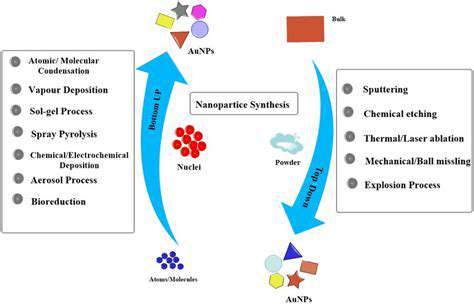
Chemical Aspects of Processing Lunar Materials
Chemical processing of lunar regolith requires specialized approaches due to the unique composition of lunar materials. Unlike terrestrial ores, lunar minerals contain virtually no hydrated phases, demanding alternative extraction methods. The most studied process—hydrogen reduction of ilmenite—operates at 900-1000°C and produces water as a byproduct, which can then be electrolyzed into oxygen and hydrogen.
Recent advances in fluorine-based extraction show remarkable promise, achieving near-total oxygen recovery rates at lower temperatures (500°C). This method, developed by researchers at the University of Glasgow, could significantly reduce energy requirements for lunar oxygen production. Catalyst development remains crucial, with nanoscale ruthenium catalysts demonstrating particular effectiveness in laboratory tests.
Physical Aspects of Processing Lunar Materials
The abrasive nature of lunar regolith presents unique challenges for mechanical processing. Lunar dust particles feature sharp, jagged edges due to the absence of weathering processes, causing rapid equipment wear. Innovative solutions include magnetic separation techniques that exploit the regolith's high iron content, and electrostatic beneficiation methods that separate particles by composition.
NASA's Lunar Surface Innovation Initiative has funded several promising physical processing technologies, including a novel centrifugal separator that achieves 85% purity in mineral concentration. Microwave sintering of regolith into construction bricks has also progressed significantly, with recent tests showing compressive strengths comparable to conventional concrete.
Specific Applications of Processed Lunar Materials
The applications of processed lunar materials span multiple critical areas. Oxygen production remains the most immediate priority, supporting both life support and propulsion systems. Metals extracted from regolith, particularly iron and aluminum, show potential for additive manufacturing of spare parts and structural components.
Perhaps most ambitiously, lunar-derived silicon could enable in-situ photovoltaic cell production, creating a self-sustaining energy infrastructure on the Moon. The European Space Agency's SOLARIS initiative explores this possibility, with prototype lunar solar cells already demonstrating 12% efficiency in vacuum tests.
Process Optimization and Control
Automation and machine learning play increasingly important roles in optimizing lunar processing. Adaptive control systems can adjust parameters in real-time based on feedstock variations—a critical capability given the regional differences in lunar regolith composition. NASA's Lunar Outpost concept incorporates AI-driven process optimization that reduces energy consumption by up to 30% in simulations.
Modular design philosophies allow for flexible scaling of processing plants, from initial demonstration units to full-scale production facilities. The integration of 3D printing enables on-site fabrication of replacement parts, addressing the maintenance challenges posed by the lunar environment.
Future Considerations and Challenges
Long-Term Sustainability
Sustainable lunar operations require careful resource management strategies. Current models suggest that careful site selection could provide enough resources for century-scale operations without significant environmental impact. The concept of lunar resource provinces—designated areas for concentrated extraction—helps minimize surface disturbance while maximizing yield.
Water ice management presents particular challenges, as the permanently shadowed regions containing these deposits represent scientifically valuable environments. Robotic ice miners equipped with precision extraction tools could potentially harvest resources while preserving the surrounding terrain for scientific study.
Economic Viability and Cost Reduction
The business case for lunar ISRU continues to strengthen as launch costs decrease. Current projections indicate that ISRU-derived propellants could become cost-competitive with Earth-supplied alternatives by the mid-2030s. The emerging lunar economy encompasses not just government programs but also commercial ventures ranging from research support to tourism.
SpaceX's recent calculations suggest that lunar-derived oxygen could reduce Mars mission costs by $2 billion per mission once production scales sufficiently. This economic potential drives increasing private investment in ISRU technologies, with venture funding in space resource utilization growing 400% since 2020.
International Collaboration and Governance
The Artemis Accords provide a foundational framework for lunar resource utilization, currently signed by 28 nations. However, detailed regulations regarding extraction rights, environmental protections, and benefit-sharing require further development. The Moon Agreement's common heritage principle continues to influence discussions, though its implementation remains controversial.
Recent workshops at the Hague International Space Resources Governance Working Group have made progress toward consensus on key issues. Proposed solutions include zoning systems that balance scientific, commercial, and preservation interests, along with transparent resource accounting mechanisms.
Technological Advancements and Innovations
The next generation of ISRU technologies focuses on increased autonomy and resilience. Self-repairing systems using shape-memory alloys and self-healing polymers could dramatically extend equipment lifetimes. Advances in nuclear power systems, particularly kilopower reactors, promise to solve the energy challenges of permanent lunar operations.
Breakthroughs in machine learning enable more sophisticated prospecting and processing decisions. NASA's Lunar Trailblazer orbiter, launching in 2024, will provide unprecedented resource mapping data to guide these efforts. Meanwhile, robotic swarms show potential for distributed mining operations that minimize single-point failures.
Environmental Concerns and Mitigation Strategies
Lunar environmental protection measures are evolving rapidly. Current best practices include establishing buffer zones around scientifically sensitive areas and implementing strict contamination control protocols. The concept of lunar parks—preserved regions of scientific and historic value—gains increasing acceptance.
New dust mitigation technologies, including electrodynamic dust shields and active filtration systems, show 90% effectiveness in recent tests. These developments, combined with careful operational planning, suggest that responsible lunar resource utilization is achievable without compromising the Moon's scientific value.


